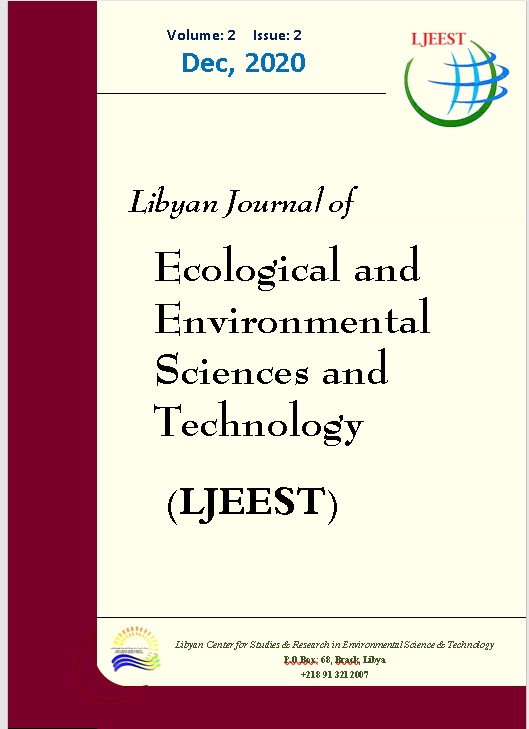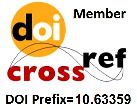Drinking Water Quality of Some Commercial Water Purification Systems at Sabratha Area, Libya.
DOI:
https://doi.org/10.63359/0442nh82Keywords:
Drinking water, Water Purification Systems, WHO standardAbstract
This study was investigated the quality of drinking water supplied in Some Commercial Water Purification Systems at Sabratha area. Water samples were collected from five stations at Sabratha region. The physicochemical parameters were mainly, pH, Alkalinity, Chloride, Nitrate, Sulfate, Magnesium, Calcium, Sodium, Potassium and TDS. The result shows that all these parameters were fall below WHO guidelines, except pH. The bacteriological result revealed that one of the studied stations was contaminated by E. coli bacteria.
References
As with all drinking water supplies, desalinated drinking water production should strive to utilize the best available source water. The desalination plants should be located away from sewage discharge wells.
Some specific recommendations include:
1. WHO guidelines standards should be applied to systems in Desalination plant.
2. Water sources used for desalinated should be check biological parameters before treated to reach microbial quality goals set on the basis of raw water contamination and risk reduction
REFERENCES
--------------------------------------------------------
Amy ,G., Ghaffour, N., Li, Z., Francis, L., Linares, R. V., Missimer, T., & Lattemann, S. (2017): Membrane-based seawater desalination: Present and future prospects. Desalination, 401, 16-21.
Aneja KR. (2008): Experiments in Microbiology, Plant Pathology and Biotechnology,4thed.NewAge International (P) limited
Brika, B. (2019): The water crisis in Libya: causes, consequences and potential solutions. Desalination and Water Treatment,351-358,
Cotruvo, J. A. (2005). Desalinations guidelines development for drinking water background Nutrients in Drinking Water, 13.
Diawara, C. K. (2008). Nanofiltration processefficiency,inwater desalination. Separation & purificationreviews, 37(3), 302-324.
Elimelech, M., & Phillip, W. A. (2011). The future of seawater desalination: energy, technology and the environment. science, 333(6043), 712-717.
Fuchs, G., & Reichel, A. (2011). A exploratory inquiry into destination risk perceptions and risk reduction strategies of first time vs. repeat visitors to a highly volatile destination. Tourism Management, 32(2), 266-276.
Haneya, O. K. E. D. (2012). Evaluation of microbiological quality of desalinated drinking water at Gaza city schools, Palestine. Evaluationof icrobiological Quality of Desalina Drinking Water at Gaza City Schools, Palestine.
Henry, R. K., Yongsheng, Z., & Jun, D. (2006). Municipal solid waste management challenges in developing countries–Kenyan case study. Waste management, 26(1), 92-100.
Lattemann, S., & Höpner, T. (2008). Environmental impact and impact assessmentofseawaterdesalination. Desalination, 220(1-3), 1-15.
Ministry of Planning, (2005) National Water and Wastewater Program Al-Sehhi, first stage report / Municipality of Sabratha -Sorman,( pp.4-10).
Morrison, G., Fatoki, O. S., Persson, L., & Ekberg, A. (2001). Assessment of the impact of point Source pollution from the Keiskammahoek Sewage Treatment Plant on the Keiskamma River-pH, electrical conductivity, oxygen-demanding substance (COD) annutrients. Water Sa, 27(4), 475-480.
Shannon, M. A., Bohn, P. W., Elimelech, M., Georgiadis, J. G., Marinas, B. J., & Mayes, A. M. (2010). Science and technology for water purification in the coming decad In Nanoscience and technology: a collection of reviews from nature Journals (pp. 337-346).
Wang, M. H. S., & Wang, L. K. (2015). Environmental water engineering glossary. In Advances in water resources engineering (pp. 471-556). Springer, Cham.
Wheida, E., & Verhoeven, R. (2007 ). An alternative solution of the water shortage problem in Libya. Water resources management, 21(6), 961-982
WHO, World Health Organization. 2011. "Guidelines for drinking water quality"… Geneva, Switzerland. MasterTree Grower Program. Melbourne, Australia.
Zhao, X., Zhou, Y., Min, J., Wang, S., Shi, W., & Xing, G. (2012). Nitrogen runoff dominates water nitrogen pollution from rice-wheat rotation in the Taihu Lak region of China. Agriculture,ecosystems environment, 156, 1-11.
Downloads
Published
Issue
Section
License

This work is licensed under a Creative Commons Attribution-NonCommercial 4.0 International License.














